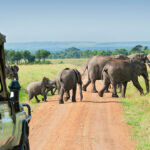As night falls over Kigali’s thousand hills, the city’s lively hum turns into a more ancient beat. The crazy noise of moto-taxis fades away, and a chorus of crickets and banana leaves rustling takes its place. From my balcony, I can see the deep green valleys that hold the city lights. They remind me all the time that we are guests in nature’s world, even in the middle of a busy capital. This deep, primal connection to the wild is something that all humans need, but in our hyper-connected, screen-filled lives, we often ignore it.
We are told to hurry, make the most of our time, and scroll. We are always surrounded by a lot of digital noise. What happened? A quiet epidemic of anxiety, burnout, and a deep feeling of being cut off from others. But there is a strong cure. It is just outside the city limits, past the paved roads and the constant notifications. It’s the call of the wild, the chance to see nature in its most natural state.
You should read this guide. It’s for the person who sees beautiful pictures of mountains and forests and feels a pang of longing, but then doubts themselves: “I’m not fit enough,” “I don’t have the gear,” “I wouldn’t even know where to start.” As a travel writer who has found peace in both a quiet forest walk and a difficult mountain trek, I’m here to tell you that outdoor travel is not just for elite athletes. Everyone can use it.
This is your complete guide to beginner outdoor travel. From picking your first adventure to figuring out what gear you need, we’ll make the process easier to understand. We’ll look into how nature escapes can change your life and how to plan amazing, eco-friendly vacations that will recharge your soul. It’s time to put down your phone and go outside to see some beautiful scenery and breathe in some fresh, pine-scented air.
The Call of the Wild: Why We Need Nature by Nature
Before we get into the “how,” we need to know the “why.” Being in nature isn’t just a nice thing to do; it’s something we need to do for our health. Our minds and bodies are made for natural environments, and being in them has deep, scientifically proven benefits.
Getting Away from the Digital Flood: How to Find Peace in a Noisy World
Our brains are always taking in new information, doing multiple things at once, and responding to things that happen. This state of “directed attention” is tiring for the mind. The best way to start over is to go outside.
Why It Matters: When we spend time in nature, we can enter a state of “soft fascination,” where our attention is held without effort. This gives our directed-attention abilities a break and a chance to recharge. The trees moving slowly, the sound of a river flowing, and the clouds drifting slowly don’t ask us for anything. This mental restoration lowers stress, makes people feel better, and boosts creativity. A weekend in nature can help you think more clearly than a week of forced relaxation at a busy resort.
The Science of Awe: How Nature Changes Your Brain to Make You Happy
Have you ever looked up at a sky full of stars or watched a whale breach the surface of the ocean and felt like you were part of something big and beautiful? That feeling is awe, and it’s a strong emotion.
Why It Matters: Research has shown that feeling awe can make people more generous, humble, and happy. It helps us see our own worries and problems in a new light. It makes us feel smaller, but it also makes us feel more connected to the world and to other people. These are the real souvenirs of traveling outside—they change the way we see life itself. Finding nature means finding a deeper, more connected part of yourself.
Useful Advice for Everyday Life: You don’t need a big canyon to feel awe. Look for a “local awe” place. It could be a park with a really big old tree, a place where you can see the whole sunset, or even just a place to watch clouds form. Every week, go to this place and just be there for 15 minutes without your phone.
Getting Started: Different Types of Nature Escapes for Beginners
When you hear the phrase “outdoor travel,” you might think of scary things like ice axes and dangerous peaks. The truth is that things are much more varied and easy to get to. Here are four kinds of vacations that are great for people who are just starting out.
The Gateway Getaway: Parks in the States and the Nation
National and state parks are great places for beginners to start their outdoor adventures. They are open to the public and have well-kept facilities and a lot of activities for people of all fitness levels.
- What to Expect: Clearly marked trails, visitor centers with maps and helpful rangers, picnic areas, and often viewpoints that you can drive to.
- **Things to Do for Beginners:
- Short, Looped Hikes: Start with “easy” trails that are 1–3 miles (2–5 km) long.
- Ranger-Led Programs: Go on guided walks or talks to learn about the plants, animals, and history of the area.
- Scenic Drives: You can see the scenery from the comfort of your car and stop at overlooks.
- Why It’s Great for Beginners: The infrastructure takes away a lot of the guesswork and worry. The presence of rangers and other visitors makes people feel safe. It’s a safe place to boost your self-esteem.
The Coastal Call: Beaches, Bluffs, and Marine Reserves
Coastal areas are a great place to relax and do things at the same time. The waves make a soothing sound that is naturally calming, and the scenery is full of places to explore gently.
- What to Expect: Sandy beaches, steep cliffs, tide pools full of life, and fresh, salty air.
- **Things to Do for Beginners:
- Beachcombing and Tide Pooling: Go to the intertidal zone to find interesting sea creatures.
- Walking Along the Coast: Take paths along the tops of cliffs to see the ocean without having to climb very high.
- Kayaking or Paddleboarding in Calm Bays: Rent gear and take a lesson to see the coast from the water.
- Why It’s Great for Beginners: The “destination” is often the beach itself, so you can go at your own pace. There are a lot of different things to do, and it’s easy to switch between exploring and relaxing.
The Forest Immersion: Rainforests and Woodlands
Being around trees gives you a special sense of peace. Forests provide shade, shelter, and a lot of interesting things to see and hear.
- What to Expect: Tall trees, the smell of wet earth and pine, sunlight shining through the trees, and the sound of birds singing.
- **Things to do for beginners:
- Forest Bathing (Shinrin-yoku): This Japanese practice is all about walking slowly and mindfully through the woods and using all of your senses. It’s not about how far apart you are; it’s about how connected you are.
- Wildlife Spotting: Look for deer, squirrels, birds, and other animals that live in the woods.
- Identifying Plants and Trees: Use a guidebook or an app like Picture This to learn about the plants and trees in your area.
- Why It’s Great for Newbies: Forest trails are usually softer on your feet and shielded from the sun and wind. Instead of doing hard physical activity, the focus can be on being aware and observing.
The Mountain Majesty: Easy Hikes and Beautiful Views
You don’t have to be a mountaineer to enjoy the mountains, even though they can be scary. Some of the best experiences can be had in the foothills and on the lower slopes.
- What to Expect: Wide views, alpine meadows, and a strong sense of scale.
- **Things to Do for Beginners:
- “Out-and-Back” Hikes: Hike to a certain viewpoint or lake and then come back the same way. This lets you turn around and go back whenever you want to.
- Taking a gondola or funicular ride: Get the views and experience of the high mountains without having to climb for hours. At the top, you can then go on a short, mostly flat hike.
- Why It’s Great for Beginners: You get a lot of rewards for your work. A short hike can lead to a stunning view that makes you feel like you’ve done something great.
The Beginner’s Playbook: How to Plan Your First Outdoor Adventure
Planning ahead is what turns a trip that could be stressful into one that is fun and safe. It’s about honoring nature and making sure you do well.
Step 1: Pick the right place to go based on how comfortable you feel.
- Be Honest About Your Fitness: If you walk your dog for 30 minutes a day, don’t plan a 10-mile hike in the mountains. Start with something you know you can do and then move on to bigger things. Success is a strong reason to keep going.
- Research Trail Difficulty: AllTrails and other websites and apps let people leave reviews about how hard, long, and high a trail is. Keep an eye on what people are saying about the trail conditions.
- Think About the Logistics: For your first few trips, pick a place that is easy to get to and has good cell service.
Step 2: The 10 Most Important Things You Need That Won’t Break the Bank
You don’t have to spend a lot of money on high-tech gear. “The 10 Essentials” is a list of safety and survival items that are good to have on any outdoor trip, even a short day hike.
- Getting Around: A map and compass are classic, but for beginners, a fully charged phone with a downloaded trail map (from an app like AllTrails or Gaia GPS) and a portable power bank are a great place to start.
- Protecting Yourself from the Sun: Wear sunscreen, sunglasses, and a hat with a wide brim. Even when it’s cloudy, you can still get sunburned.
- Insulation: More clothes. The weather can change in a flash. Even on a warm day, bring a fleece or a light puffy jacket. Tip: Don’t use cotton, because it loses its ability to keep things warm when wet. Choose wool or synthetic fabrics.
- Light: A flashlight or headlamp, even if you plan to be back before dark.
- First-Aid Supplies: A ready-made first-aid kit with everything you need for cuts, scrapes, and blisters.
- Fire Starter: A lighter or matches that won’t get wet. Only for emergencies.
- Tools and Repair Kit: A knife or multi-tool.
- Food: More food. Bring more snacks than you think you’ll need. Trail mix, granola bars, and fruit are great high-energy snacks.
- Hydration: More water. Bring more than you think you’ll drink. A hydration reservoir, like a CamelBak, is handy, but a simple reusable water bottle works just as well.
- Emergency Shelter: A light blanket or bivy sack for emergencies. It is small, inexpensive, and could save your life if you get stuck outside overnight.
Step 3: Safety First: Be aware of navigation, the weather, and wildlife
- Tell Someone Your Plan: Always leave a detailed itinerary with a friend or family member, including where you are going and when you expect to be back.
- Check the Weather Over and Over Again: Check the weather forecast all the way up to the time you leave for the trailhead. If the weather looks bad, be ready to change or cancel your plans.
- Wildlife Etiquette: Learn about the animals that live in the area. If you see a bear, snake, or other big animal, you should know what to do. The most important thing to remember is to stay away from wildlife, never feed them, and make noise while you hike so you don’t surprise them.
Step 4: Booking Smart: How to Find Eco-Lodges and Eco-Friendly Places to Stay
The place you stay can have a big effect on the environment. To have a truly eco-friendly vacation, stay in places that care about the environment.
- Look for Certifications: Look for lodges that have eco-certifications from well-known groups like Green Globe or Rainforest Alliance.
- Ask Questions: Before you book, find out how they do things. Do they hire people from the area? How do they deal with trash and water? Do they help with conservation projects in their area?
- Choose Locally-Owned: Picking a smaller, locally-owned guesthouse instead of a big international chain often means that your money will stay in the community. Staying at a community-run lodge outside of Akagera or Nyungwe National Park in Rwanda directly helps the people who take care of that area.
The Green Compass: How to Plan Eco-Friendly Vacations
To really “discover nature,” you have to become its advocate. This means taking care of the beautiful places we’ve come to enjoy and making sure that our presence doesn’t hurt them.
The Leave No Trace Principles: A Traveler’s Code of Conduct
The Leave No Trace Center for Outdoor Ethics has seven simple but powerful rules that are the foundation of responsible outdoor recreation.
- Plan Ahead and Get Ready: This is what we’ve talked about so far. It keeps you from getting into situations where you might have to make bad decisions.
- Travel and Camp on Durable Surfaces: Stay on the path that is marked. Walking off the trail damages plants and causes erosion.
- “Pack it in, pack it out” means to throw away all of your trash, including food wrappers, fruit peels, and toilet paper. In the wild, there aren’t any trash cans.
- Leave What You Find: Let others see how beautiful it is. Don’t move rocks, plants, or other natural things.
- Reduce the Effects of Campfires: Use a small stove to cook. If you really need a campfire, use an existing fire ring and make sure it is cold before you leave.
- Respect Wildlife: Keep your distance when you see animals. Don’t ever follow, get close to, or feed them.
- Be Polite to Other Visitors: Everyone is there to enjoy the peace of nature. Be polite and keep noise to a minimum on the trail.
Ethical Wildlife Encounters: Watching, Not Disturbing
A big part of many “nature escapes” is the thrill of seeing an animal in the wild. But the animal has to agree to this.
- Use binoculars or a zoom lens: This lets you see the animal up close without getting too close and stressing it out.
- Never Use Drones to Take Pictures of Wildlife: Drones are very stressful for most animals and are against the law in many parks.
- Pick Your Tour Operators Carefully: When going on a whale-watching trip or a safari, pick a company that has a good reputation for being honest. Find guides who care about protecting the environment, not just getting the best picture. When I went gorilla trekking in Rwanda’s Volcanoes National Park, I learned a lot about this. There were strict distance rules, a short amount of time, and we had to be very quiet so that the gorillas wouldn’t notice us.
Inspiration Station: Easy Nature Getaways for Beginners All Over the World
Want some ideas? Here are a few amazing places where you can use your new skills.
- For the Person Who Loves the Forest:
- The Black Forest, Germany: A fairytale land with thousands of miles of well-marked trails, cute villages, and cuckoo clocks.
- Nyungwe Forest National Park, Rwanda: This is one of the oldest rainforests in Africa. You can see amazing chimpanzees, birds, and walk through the canopy.
- For the Person Who Loves Mountains:
- The Scottish Highlands, UK: Beautiful lochs and glens. The hike to the Old Man of Storr on the Isle of Skye is hard, but it’s worth it.
- Zion National Park, USA: The Pa’rus Trail and the Emerald Pools Trail are easy to walk and have amazing views of the canyon.
- For the Coastal Traveler:
- The Pembrokeshire Coast Path, Wales: A beautiful national trail with easy-to-manage day sections that take you past beautiful beaches, dramatic cliffs, and quaint fishing villages.
- Abel Tasman National Park in New Zealand is known for its clear turquoise water and golden beaches. You can hike parts of the coastal trail or go kayaking to see the area.
The Last Word: Your Adventure Starts with a Single Step
The modern world pulls us in a million different ways, making us feel broken and tired. Nature only pulls us in one direction: toward who we really are. It only asks for our presence, and in return, it gives us clarity, perspective, and a deep sense of peace.
You don’t have to be an experienced adventurer to answer its call. You only need a little bit of curiosity and the guts to get started. Begin with small things. Go to a park near you. Make plans for a short hike. You will be able to do bigger things in the future because of the confidence you gain from each small success.
To “discover nature” means to start a lifelong journey of learning about yourself and the world around you. The path is waiting.
Source:
https://www.apa.org/news/press/releases/2023/02/awe-essential-human-experience
https://www.rei.com/learn/expert-advice/ten-essentials.html
https://lnt.org/why/7-principles/




